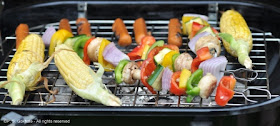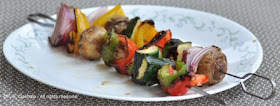When I was a growing up, as a treat, my Mom used to get me a packet of these special heart shaped cookies. I think they were called Little Hearts. Last year I happened to spot a packet of heart shaped cookies in the local store. They had a a lovely glaze, and they reminded me of those childhood cookies, though they were much larger in size. So, I decided to try them out and bought a packet. I am so glad that I did because these turned out to be almost the same. Of course, I never saw them in the store again and I also hadn't written down the name of the cookie that I could search for it. Then, a few months later, I caught a cooking show online and saw that it was called Palmiers or Elephant ears and was rather easy to make. I furiously noted down the recipe. I finally made it a couple of weeks ago. I remembered that I had a packet of frozen puff pastry sheets in the freezer and needed to use them up. I didn't have a lot of time and wanted to make something easy, and as I was browsing through my recipe book, I came across the palmiers recipe. It took less than an hour including the baking time to cook these wonderfully delicious cookies and all of us enjoyed it thoroughly with some coffee.
Ingredients
1 cup sugar
1/8 tsp salt
1 sheet puff pastry, defrosted per package instructions
Method
Preheat the oven to 400 F. Line a cooking sheet with parchment paper.
Mix the sugar and salt well. Spread out half a cup of the sugar and salt mix, onto the surface on which you will roll out the pastry sheet. Spread it out into an even layer of about 13 by 13 inch square. Then spread the pastry sheet on this layer of sugar. Then spread the remaining half cup of sugar and salt mixture onto the top of the pastry sheet so that the pastry is between two layers of the sugar and salt mix.
Now roll the pastry sheet out so that it is approximately 13 by 13 inches in size. This will embed the sugar onto the top and the bottom side of the pastry sheet. Now, fold the sides square of the square towards the center so that they meet exactly midway. Repeat this step and again fold the sides of the folds created in the first step towards the center, so they meet midway. Then fold one half over the other half. Finally, it will look like there are 6 layers of the pastry sheet on top of each other formed into a roll.
Then cut the dough roll into thin pieces about half a centimeter in width. Place the slices cut side up onto the cookie sheet. Bake this in the oven for 7 - 10 minutes on one side till caramelized. Then flip the cookies over and bake the cookies on the other side for 4-5 more minutes till cookies are caramelized on the other side as well. As these cookies bake, the folds will open and puff up and the cookies will get the heart shape. Cool these on a cooling/baking rack.
Tips
There will be some sugar left after you roll out the pastry dough, you can sprinkle this on top of the cookies before baking for additional sweetness. You can also mix in cinnamon into the sugar, salt mixture for a different flavor. Store these after they are completely cool in an airtight container. The crisp cookies last for a couple weeks and do not have to be refrigerated.
1 cup sugar
1/8 tsp salt
1 sheet puff pastry, defrosted per package instructions
Method
Preheat the oven to 400 F. Line a cooking sheet with parchment paper.
Mix the sugar and salt well. Spread out half a cup of the sugar and salt mix, onto the surface on which you will roll out the pastry sheet. Spread it out into an even layer of about 13 by 13 inch square. Then spread the pastry sheet on this layer of sugar. Then spread the remaining half cup of sugar and salt mixture onto the top of the pastry sheet so that the pastry is between two layers of the sugar and salt mix.
Now roll the pastry sheet out so that it is approximately 13 by 13 inches in size. This will embed the sugar onto the top and the bottom side of the pastry sheet. Now, fold the sides square of the square towards the center so that they meet exactly midway. Repeat this step and again fold the sides of the folds created in the first step towards the center, so they meet midway. Then fold one half over the other half. Finally, it will look like there are 6 layers of the pastry sheet on top of each other formed into a roll.
Then cut the dough roll into thin pieces about half a centimeter in width. Place the slices cut side up onto the cookie sheet. Bake this in the oven for 7 - 10 minutes on one side till caramelized. Then flip the cookies over and bake the cookies on the other side for 4-5 more minutes till cookies are caramelized on the other side as well. As these cookies bake, the folds will open and puff up and the cookies will get the heart shape. Cool these on a cooling/baking rack.
Tips
There will be some sugar left after you roll out the pastry dough, you can sprinkle this on top of the cookies before baking for additional sweetness. You can also mix in cinnamon into the sugar, salt mixture for a different flavor. Store these after they are completely cool in an airtight container. The crisp cookies last for a couple weeks and do not have to be refrigerated.











































